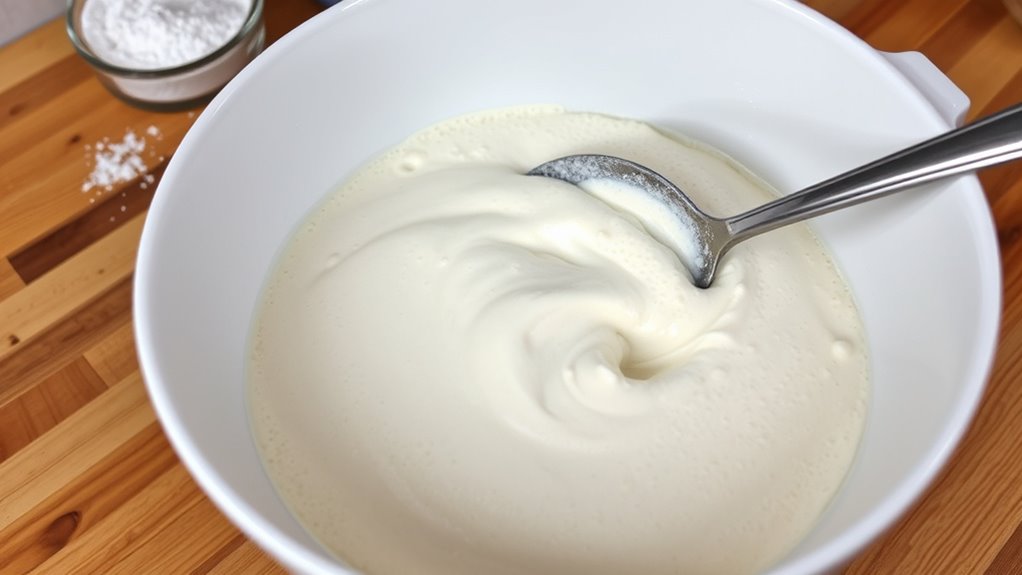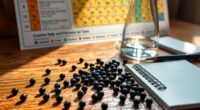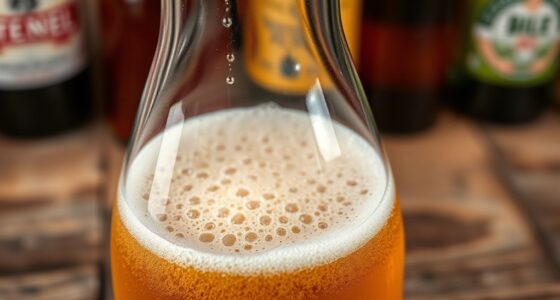Baking soda and baking powder help your baked goods rise by producing carbon dioxide gas through chemical reactions. Baking soda, a pure base, reacts immediately with acids like vinegar or lemon juice, releasing gas quickly. Baking powder, which contains baking soda plus acids, reacts in stages—once when mixed and again during baking—giving a steady lift. Understanding how these leaveners work guarantees perfect texture and flavor—discover more about their roles and how to use them right.
Key Takeaways
- Baking soda is a pure base that reacts immediately with acids, releasing CO₂ for leavening during mixing and baking.
- Baking powder contains baking soda plus acids, providing controlled CO₂ release when moistened and heated.
- Double-acting baking powder reacts twice—once during mixing and again during baking—ensuring steady leavening.
- Acid-base reactions neutralize excess acidity, balancing flavor and producing CO₂ bubbles that create a light, airy texture.
- Proper measurement and timing of leaveners maximize gas retention, volume, and the desired crumb in baked goods.
Understanding the Chemical Composition of Baking Leaveners

To understand how baking leaveners work, it’s important to know their chemical makeup. Baking soda, or sodium bicarbonate (NaHCO₃), is a white, crystalline, odorless solid that’s basic in nature. It naturally occurs in mineral form as nahcolite deposits and is produced industrially through the Solvay process, involving carbon dioxide, ammonia, water, and brine. This process allows for large-scale, cost-effective production of baking soda, making it widely available. Baking powder, on the other hand, contains baking soda plus acids like monocalcium phosphate and sometimes other acid salts, along with fillers such as cornstarch. These acids are stable until they’re moistened or heated, allowing controlled gas release. While baking soda is pure sodium bicarbonate, baking powder combines it with acids for staged reactions. This mixture enables leavening without needing external acids in recipes, giving baked goods their rise.
The Activation Process of Baking Soda and Baking Powder
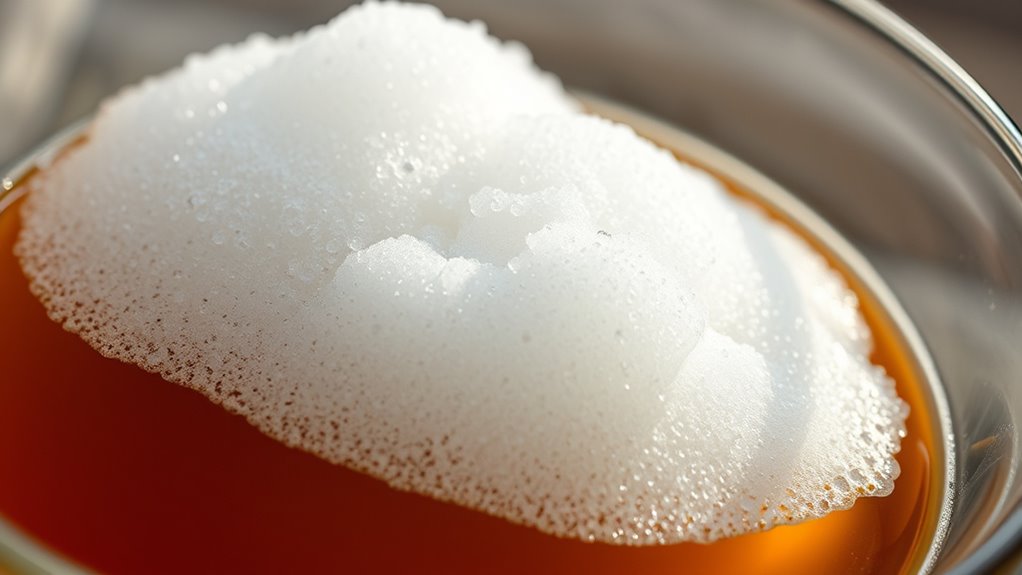
The activation of baking soda and baking powder begins when you combine them with liquid and heat, triggering chemical reactions that produce carbon dioxide gas.
With baking soda, you need an acidic ingredient and liquid; the reaction happens immediately, releasing gas that makes your batter rise. Heat can also activate baking soda, but without acid, it might cause off-flavors.
Baking powder, which contains both acid and base, only needs liquid to start reacting. Most are double-acting, reacting once when mixed and again when heated.
The first reaction provides initial lift, while the heat-activated second reaction adds more rise during baking. Proper activation depends on the right amount of acid and the timing of mixing and baking to achieve the desired lightness and texture.
Understanding the chemistry behind these reactions is essential for bakers to get perfect results every time.
How Baking Soda Reacts With Acidic Ingredients
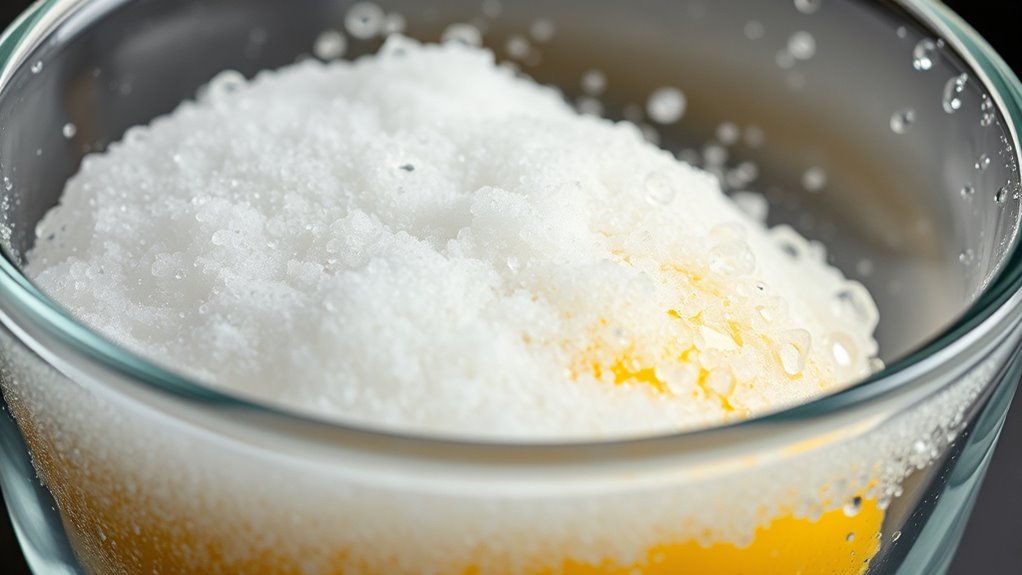
When baking soda encounters acidic ingredients, a rapid chemical reaction occurs that produces carbon dioxide gas, which helps your baked goods rise. The sodium bicarbonate (NaHCO₃) reacts with hydrogen ions (H⁺) from acids like vinegar, lemon juice, or yogurt, forming water, a salt, and CO₂ gas. This gas forms bubbles that expand during baking, creating the leavening effect. The reaction is immediate and depends on moisture, so acidic ingredients must be present for effective leavening. Different acids produce various salts—vinegar yields sodium acetate, while cream of tartar creates sodium potassium tartrate. This process not only leavens but also neutralizes excess acidity, balancing flavors and texture. The pH of the mixture influences the rate and amount of CO₂ produced, with more acidic mixtures generally producing more gas and a quicker reaction. Proper proportions of baking soda and acid are key to ideal rising and taste.
The Double-Acting Nature of Baking Powder

Double-acting baking powder contains two types of acids that react at different stages, ensuring your baked goods rise properly.
The fast-acting acid reacts immediately when moistened, producing carbon dioxide during mixing, which helps start leavening.
The slow-acting acid remains dormant until the batter is heated in the oven, where it reacts to release additional gas, giving your baked goods extra lift.
This two-stage process creates a steady release of carbon dioxide, resulting in a finer, more uniform crumb and increased volume.
Because of this, double-acting baking powder offers greater stability and reliability compared to single-acting types.
It allows you to mix your ingredients and bake with confidence, knowing your batter will rise consistently during baking, leading to better texture and appearance.
Using smarter devices in baking can help monitor and optimize reactions, similar to how high-tech vaporizers enhance user experiences.
The Role of Leaveners in Creating Texture and Lightness
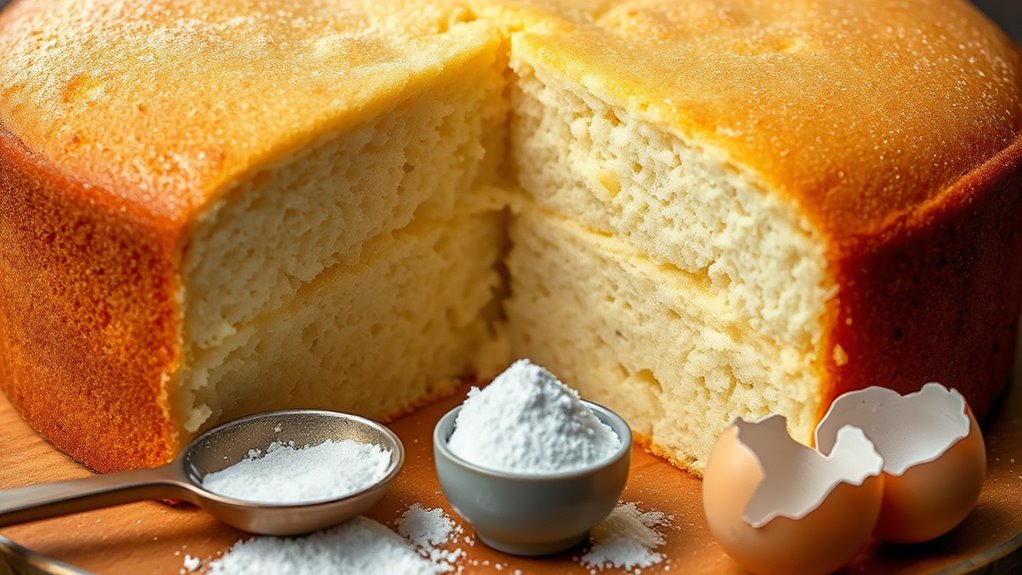
Have you ever wondered how leaveners transform dense batter into light, airy baked goods? They do this by releasing carbon dioxide gas, which expands the dough or batter, creating tiny air pockets. Proper gas distribution during mixing ensures even crumb and consistent texture. Chemical leaveners like baking soda and baking powder produce CO2 quickly when combined with moisture and acid or heat, giving cakes and quick breads their rise. Proper gas distribution during mixing ensures a uniform crumb and consistent texture. If too much or too little gas is released, your baked goods can collapse or become dense. Leaveners also influence crumb structure by forming evenly distributed air cells, making the final product tender and fluffy. Balancing leavening and batter consistency is key to achieving the desired lightness and delicate texture.
Flavor and Color Development in Baked Goods

Ever wonder how baking soda and baking powder influence the flavor and color of your baked goods? Baking soda can give a metallic or soapy taste if used excessively, so you need to balance it carefully. When combined with acidic ingredients like buttermilk or yogurt, it enhances flavor by neutralizing its sharpness. Additionally, the choice of leavener can impact the performance of the oven, affecting how the baked good develops color and texture. Baking powder, on the other hand, is neutral and helps maintain a consistent flavor profile. Both leaveners affect color: baking soda promotes browning and darker crusts through alkalinity, while baking powder yields lighter, softer crusts. The Maillard reaction, which creates browning, depends on pH levels influenced by these leaveners. Temperature and baking time also play roles in color development, making precise measurement key to achieving the desired flavor and appearance.
Proper Handling, Storage, and Measurement of Baking Leaveners

Proper handling, storage, and measurement of baking leaveners are essential to guarantee their effectiveness in your baked goods. Store baking soda in airtight, moisture-proof containers to prevent odor absorption and deterioration. Baking powder should stay in its original sealed can or a similar airtight container, kept away from heat and light to maintain potency. Avoid cardboard boxes, as they allow moisture and odors in; glass or metal containers are better. Keeping leaveners dry and away from refrigeration or freezing, which can cause moisture exposure and activate them prematurely, is also important. Regularly test their freshness—fizzing in hot water for baking powder or bubbling with vinegar for baking soda indicates they’re still active. Use dry, clean measuring spoons, leveling off for accuracy, and promptly close containers after use to preserve their potency. Additionally, storing leaveners in proper environmental conditions helps ensure their longevity and effectiveness.
Common Mistakes and Tips for Optimal Results
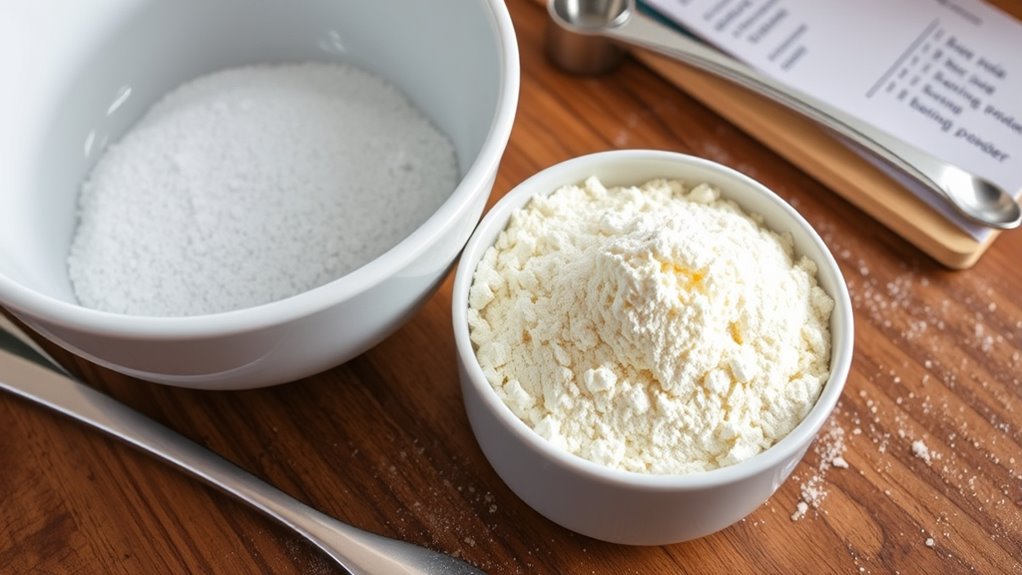
Misunderstanding how baking soda and baking powder activate can lead to flat or oddly flavored baked goods. Baking soda needs an acid, like yogurt or lemon juice, to produce carbon dioxide for rising. Without acid, it causes dense textures and a metallic or soapy taste.
Baking powder, containing both acid and base, activates with moisture and heat, so it’s more forgiving but requires correct measurement. Confusing the two can result in poor rise and off-flavors, especially if you substitute one for the other improperly.
Precise measurement is essential—too much baking soda or baking powder can ruin texture and flavor. Also, don’t overmix after adding leaveners, as this releases gas and reduces rise. Bake promptly after mixing to maximize leavening efficiency. Additionally, understanding the role of contrast ratio in baking can help ensure your baked goods have the right texture and appearance.
Frequently Asked Questions
Can Baking Soda Be Used Alone as a Leavening Agent?
Yes, you can use baking soda alone as a leavening agent if your recipe includes an acidic ingredient like lemon juice or buttermilk.
When combined, baking soda releases carbon dioxide, making your batter rise. Just remember, it reacts quickly and needs to be baked immediately after mixing.
Also, make certain your baking soda is fresh and the recipe has enough acid to activate it properly.
How Does Baking Powder Affect the Flavor of Baked Goods?
Baking powder’s neutral nature keeps baked goods tasting true, but too much can turn it bitter and metallic. You might notice a tinny aftertaste if it contains aluminum.
When you measure carefully and follow recipes, baking powder leavens without compromising flavor. Excessive use leaves behind an unpleasant alkaline taste, impacting both taste and texture.
What Causes Baking Soda to Leave a Metallic Taste?
You might notice a metallic taste from baking soda if it doesn’t fully react with an acid in your recipe. When baking soda remains unneutralized, it decomposes during baking, releasing alkaline residues that can taste soapy or metallic.
Using enough acid, like lemon juice or vinegar, helps neutralize the baking soda, preventing that off-flavor.
Also, beware of aluminum in some baking powders, which can add to that metallic aftertaste.
Is There a Way to Test if My Baking Powder Is Still Effective?
You want to know if your baking powder still works. To test it, mix 1/2 teaspoon of baking powder with 1/4 cup of boiling water; if it bubbles vigorously, it’s active.
Alternatively, put a teaspoon in hot water and watch for fizzing. If no bubbles form, it’s time to substitute your baking powder.
Regular testing helps guarantee your baked goods rise perfectly every time.
How Do I Adjust Recipes When Substituting Baking Soda for Baking Powder?
When you’re thinking about swapping baking soda for baking powder, it’s like balancing a delicate dance. Use about a quarter teaspoon of baking soda for each teaspoon of baking powder needed.
Remember to add an acid, like cream of tartar or lemon juice, to activate it. Adjust the liquids slightly if you introduce more acid.
With careful tweaks, your baked goods will rise beautifully without missing a beat.
Conclusion
Understanding how baking soda and baking powder work is like revealing a secret code to perfect baked goods. When you grasp their chemistry, you harness their power to create light, airy treats that rise beautifully and develop rich flavors and colors. Handle them with care, measure accurately, and avoid common mistakes. With this knowledge, your baking becomes a dance—each ingredient playing its part harmoniously, turning simple ingredients into delightful masterpieces that leave everyone asking for more.
